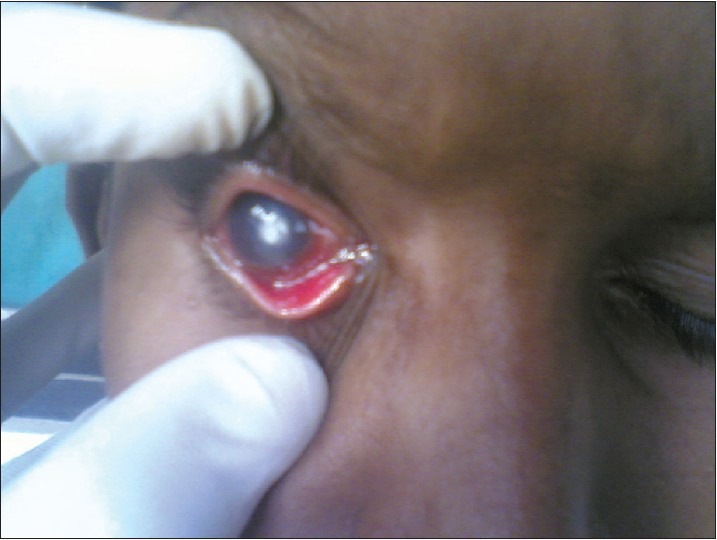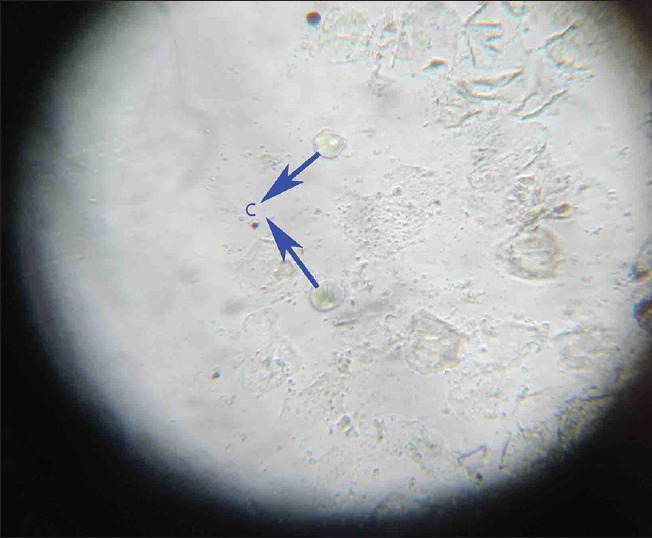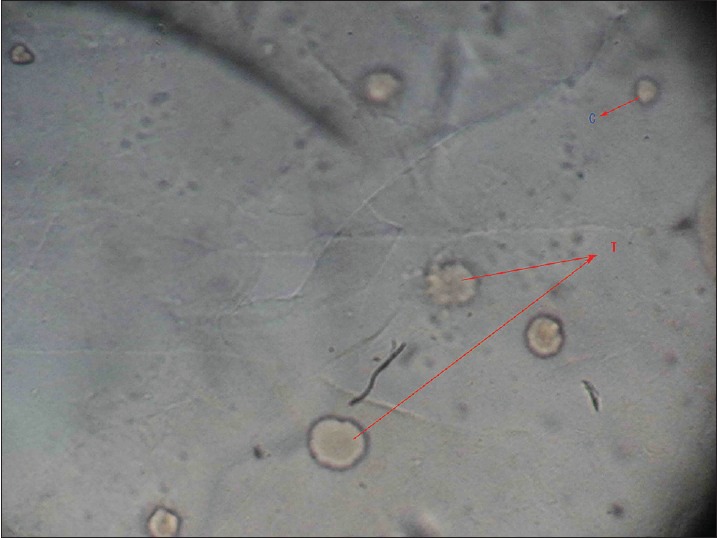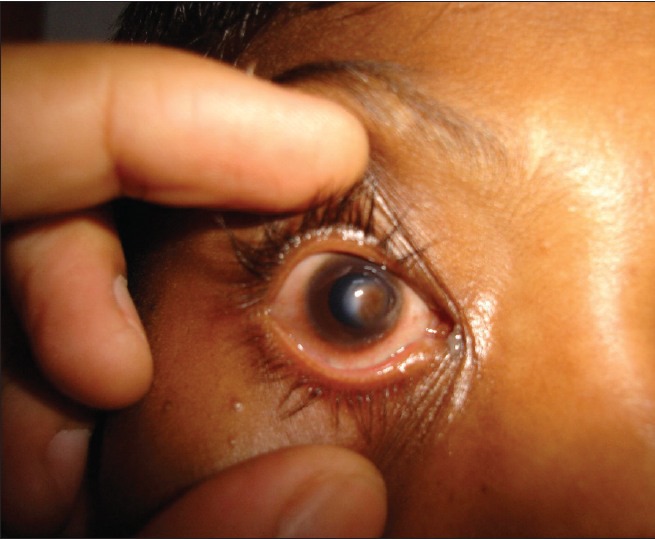Dear editor,
About 65% of non-viral keratitis develops following injuries and Gram positive cocci are an important cause.[1,2] Keratitis caused by free living amoeba (Acanthamoeba) causes devastating ocular damage is also associated with trauma and contamination with water, soil, sewage, etc.[3] People wearing contact lenses are prone to get infected.[4] Acanthamoeba keratitis is usually treated with biguanides with neomycin, propamidine, and/or clotrimazole for weeks to months, but still lacks a consensus protocol.
We report a case of keratitis owing to Staphylococcus aureus and Acanthamoeba treated successfully with antibiotic followed by corneal debridement and topical use of ointment containing neomycin-polymyxin B-bacitracin.
A 12-year-old boy reported to the Ophthalmology Out-Patient Department with difficulty in vision, redness, pain, watering, blepharospasm, and photophobia of the right eye following the history of 3-day-old wood splinter injury. Examination showed central corneal ulcer with conjunctival and cilliary congestion and hypopyon with perception of Hand Movement at 2 feet.
Direct mount of corneal scraping in 10% KOH was negative for fungal elements but culture yielded growth of S. aureus. The patient was treated with 0.5% w/v Moxifloxacin eye drop (as per sensitivity) along with 1% Atropine drop. After initial recovery, he developed blurring of vision, redness and pain after a month. On examination, a stromal abscess in the cornea was seen [Figure 1], which showed stellate, polygonal, double walled cysts on direct KOH mount [Figure 2]. Culture in non-nutrient agar medium with Escherichia coli overlay showed growth of Acanthamoeba in 48 h [Figure 3]. Bacteriological and fungal culture yielded no growth.
Figure 1.

Corneal ulcer before treatment
Figure 2.

10% KOH mount of the corneal scraping showing Acanthamoeba cysts
Figure 3.

Culture in non-nutrient agar medium with Escherichia coli overlay showing Acanthamoeba trophozoites and cysts
The patient was treated with topical polymyxin B sulphate 5000 units, Bacitracin Zinc 400 units, Neomycin sulphate 3400 units, four times a day along with a cycloplegic drug. The patient responded well and within a month showed complete healing of the ulcer leaving behind a small brownish corneal opacity [Figure 4]. Visual acuity returned to 4/60.
Figure 4.

Healed ulcer with pigmented opacity after treatment
The case of Acanthamoeba keratitis masked with initial staphylococcal infection posed a challenge to the treating doctor. In the initial setting, the antibiotic could eliminate S. aureus but could not relieve the patient from recurrence of symptoms. However, in the second setting, diagnosis could be established and treated specifically. In the initial KOH mount, Acanthamoeba cysts could not be found. This may be because of few cysts in the initial lesion and also because culture was not done in the earlier setting for detection of Acanthamoeba. It may also be due to subsequent infection of the staphylococcal ulcer with Acanthamoeba species. Pure growth of S. aureus in the blood agar plate helped the treating doctor to give antibacterial treatment initially. Early treatment of Acanthamoeba keratitis increases the likelihood of a cure; however, the treatment protocol is yet to be clear.[5] Biguanides, and chlorhexidine, diamide propamidine, neomycin and the antifungal clotrimazole are some of the options that have been tried in different combinations with varying degrees of success. The biguanides are the primary agents used as they act on both trophozoites and cysts and are less toxic to the cornea.[5] The present case was treated successfully with initial topical antibiotic eye drop (Moxifloxacin) and topical eye ointment containing neomycin-polymyxin B-bacitracin.
Repeated corneal debridement and topical chlorhexidine eye drops have also been reported to be successful in treating Acanthamoeba keratitis with minimal sequelae.[6] In our case, corneal debridement and topical Neosporin eye ointment caused clearance of the inflammation after 2 weeks of medication. Though combination therapy is advocated, in the present case, surgical debridement of the stromal abscess led to good penetration of the medication and cure thereafter.
REFERENCES
- 1.Srinivasan M. Infective keratitis: A challenge to Indian ophthalmologists. Indian J Ophthalmol. 2007;55:5–6. doi: 10.4103/0301-4738.29487. [DOI] [PubMed] [Google Scholar]
- 2.Bharathi MJ, Ramakrishnan R, Vasu S, Meenakshi, Palaniappan R. Aetiological diagnosis of microbial keratitis in South India: A study of 1618 cases. Indian J Med Microbiol. 2002;20:19–24. [PubMed] [Google Scholar]
- 3.Sharma S, Garg P, Rao GN. Patient characteristics, diagnosis, and treatment of non-contact lens related Acanthamoeba keratitis. Br J Ophthalmol. 2000;84:1103–8. doi: 10.1136/bjo.84.10.1103. [DOI] [PMC free article] [PubMed] [Google Scholar]
- 4.Hassanlou M, Bhargava A, Hodge WG. Bilateral Acanthamoeba keratitis and treatment strategy based on lesion depth. Can J Ophthalmol. 2006;41:71–3. doi: 10.1016/S0008-4182(06)80070-0. [DOI] [PubMed] [Google Scholar]
- 5.Sakamoto M, Fujioka M, Mukuno H, Katakami C. A case of Acanthamoeba keratitis that was treated effectively with corneal debridement and topical chlorhexidine drops. Folia Ophthalmologica Japonica. 2004;55:841–4. [Google Scholar]
- 6.Sharma S, Srinivasan M, George C. Acanthamoeba keratitis in non-contact lens wearers. Arch Ophthalmol. 1990;108:676–8. doi: 10.1001/archopht.1990.01070070062035. [DOI] [PubMed] [Google Scholar]


